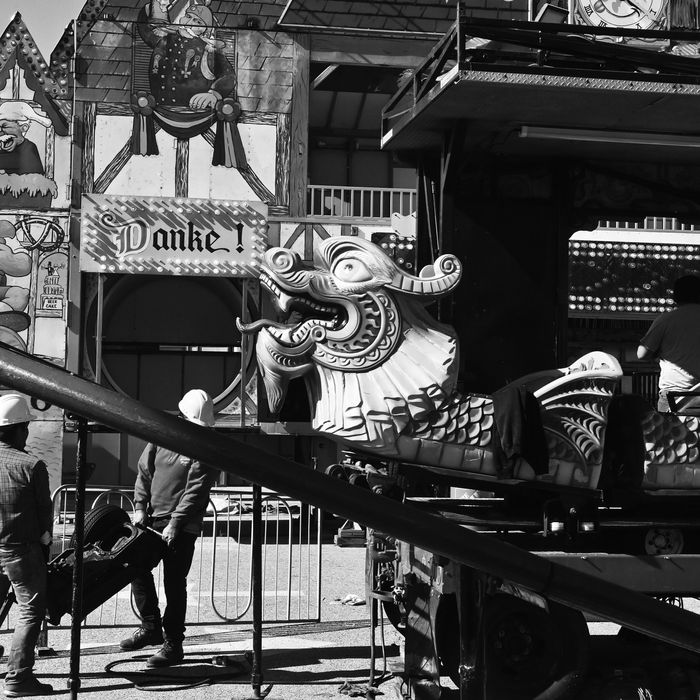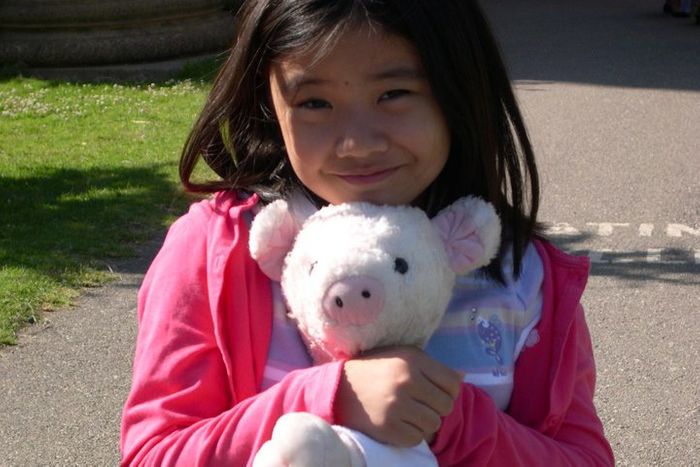
Photo: Jim Ruymen/UPI/Shutterstock
Born in the Year of the Pig, I grew up seeing the symbol of good fortune and prosperity everywhere. Pigs were an auspicious sign to be born under, and my parents took that seriously. Glass, wood, and ceramic pig figurines decorated every shelf in our house, and garish stuffed pigs lined my dresser and the tops of our closets. But classmates I invited over often found my parents’ obsession with pigs strange and overwhelming, so as a kid I shied away from embracing my Chinese-astrology counterpart.
That all changed one day when my uncle took 6-year-old me to the locally beloved SUPERCO appliance store on Garvey and Atlantic in Monterey Park, California. In the parking lot, a large picnic blanket covered with children’s toys caught my attention. An older Chinese woman sat on the sidewalk beside it, a black visor shielding her eyes from the sun. A plush, pale-pink pig stood out to me in the sea of fluorescent animals. “I want that one. I’ll name her Piggy,” I said in Mandarin to my uncle, who knew my distaste for pigs and was surprised at my choice. Unlike the Chinese sculptures that stood out around our house, this pig looked like any other American kid’s stuffed animal; I could keep this part of my heritage with me everywhere I went while still feeling like a “normal” kid.
For many people reading the news this week, Monterey Park is just a place. It’s where the country’s deadliest mass shooting in months took place last weekend, in which a gunman killed 11 people and injured nine others at a dance studio across the street from a Lunar New Year festival. But for me, Monterey Park brims with memory. San Gabriel, my hometown, grazes the northeast corner of the Asian-majority city located about seven miles east of Downtown Los Angeles, nestled between Alhambra to the north and Rosemead to the east. Growing up, we’d visit at least once a week to run errands or grab a bite to eat. On afternoons I had a bad day at school, I’d eat my feelings away with the macaroni Spam soup at JJ’s or the baked spaghetti at OK Café. Whenever I had a persistent cough, we’d visit the Chinese medicine doctor and stock up on herbs. If my mom got the rare urge to cook fresh seafood, we’d pick out a live fish from the clear glass tanks at HK Supermarket; once, we got home only to realize the fish was still alive.
Frequently referred to as the United States’ first “suburban Chinatown,” Monterey Park is actually better described as the country’s first ethnoburb, a cluster of residential areas and business districts created to preserve their specific ethnic identity. No one factor fueled the Asian-population boom that began in the 1970s in the surrounding San Gabriel Valley. White flight, eager developers like Frederic Hsieh, and the Immigration and Nationality Act of 1965, which facilitated the entry of hundreds of thousands of Asian immigrants previously barred from the country, all played roles in the area’s ethnic-cultural shift. But the change was undeniable. By 1987, the L.A. Times reported that the influx of Asians in San Gabriel Valley “had profound implications for nearly every institution of civic life, affecting the way schools, police, city halls, courts and post offices conduct their day-to-day business.”
Even though we lived in the Asian sanctuary of the San Gabriel Valley, I attended mostly white private schools in Pasadena, where diversity in class and culture was a rarity in the student body. Since school constituted nearly all of my social fabric, I felt immense pressure to assimilate into whiteness from first grade into my mid-teens. I often felt I needed to defend my mom’s accented English, or overexplain why the bak kwa (Chinese pork jerky) I brought to school looked so different from their beef jerky, even though it was effectively the same.
There are some other memories that carry such a visceral hurt, it feels like they happened yesterday. In first grade, the only other Chinese boy told me to “speak English” when I went up to say hi on the first day of school. In third grade, a white friend I had over after school told me my dad “smelled homeless” because he couldn’t speak English and lit incense at our Buddhist altar. In sixth grade, I watched a group of white boys steal a Chinese classmate’s red envelope out of his backpack on Lunar New Year, emptying the contents into their own wallets and throwing the red, gold-foiled lined sleeve in the trash. Seeing this happen filled me with a rage I can’t find the words to adequately express to this day.
Photo: Courtesy of Eda Yu
But in Monterey Park’s bustling Chinese community, my parents and I found a confidence we lacked in predominantly white spaces. My mom transformed into a graceful, elegant woman holding her own as she haggled over mahogany chairs, a far cry from the nervous woman I went shopping with in Old Town Pasadena. My father would order for us at restaurants in Cantonese and Taiwanese, a stark contrast to how he stuttered through simple English phrases at Denny’s. And when we visited during Lunar New Year, I felt downright invincible as I looked at the red lanterns hanging from every storefront, the festive spirit of the city washing over me. I didn’t know it then, but Monterey Park’s refusal to assimilate into America’s racial binary helped me proudly embrace my Asian American identity in high school and college.
As I got older, of course, a lot of things changed. I moved away from the SGV, first to the Bay Area and then to Los Angeles. The SUPERCO closed down not too long after I got my first rice cooker to take to college. Our Chinese medicine doctor retired. Mama Lu’s, a dumpling spot we used to frequent, now cites a two-hour wait on busy nights. I was last in Monterey Park just a couple weeks ago, catching up with a friend I hadn’t seen in years at JJ’s on an unusually rainy night, talking for hours over chrysanthemum tea and baked spaghetti like old times.
My partner and I had talked about going to the Lunar New Year festival the night of the shooting, but we didn’t finish cleaning the house in time. A few hours later, a friend texted me asking, “Are you okay? Did you go to the Lunar New Year festival in Monterey Park?” That’s when I saw the tweets and headlines. I texted my mom, asking if any of our extended family went, and called a friend who was there earlier that day. Thankfully, everyone I knew was safe and accounted for.
It felt surreal that such extraordinary violence could happen at the same intersection where my family picked up herbs, where the SUPERCO where I got Piggy once stood. In the days since, all I’ve been thinking about is how much I want to go back to the city, fill my favorite restaurants with the people I love most, and help the victims’ families and Star Ballroom and get back on their feet. Monterey Park has done so much to lift me up over the years. Now it’s time for me to do the same for this community.
"asian" - Google News
January 27, 2023 at 02:22AM
https://ift.tt/FsJj5Vq
Monterey Park Helped Me Embrace My Asian American Identity - The Cut
"asian" - Google News
https://ift.tt/w4OifFZ
Shoes Man Tutorial
Pos News Update
Meme Update
Korean Entertainment News
Japan News Update


No comments:
Post a Comment